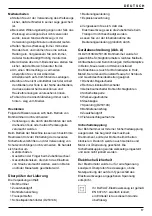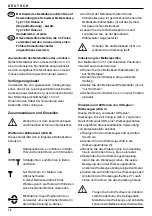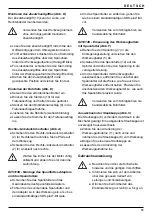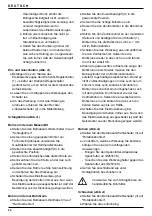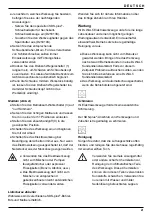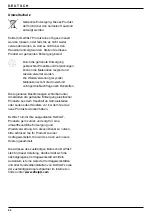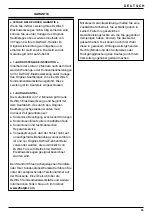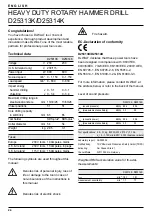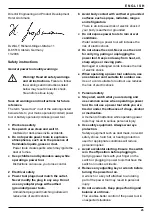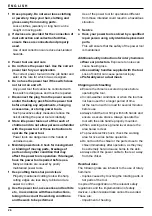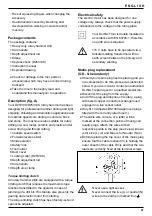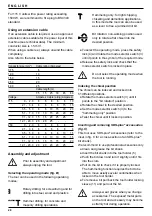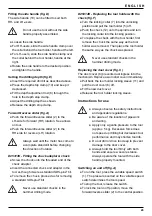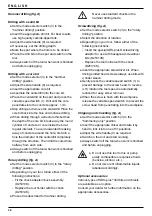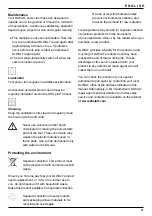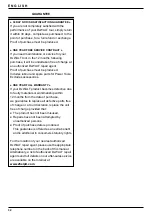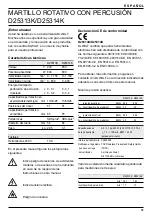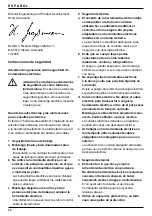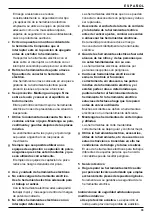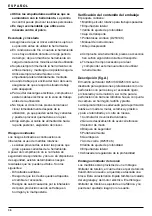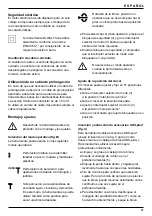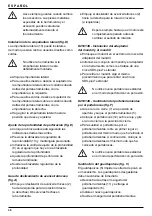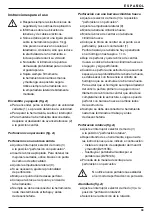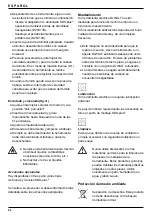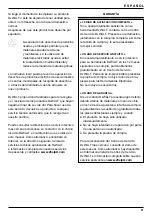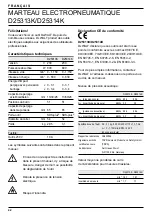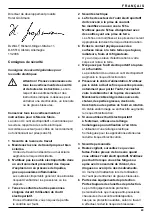
28
E N G L I S H
For 115 V units with a power rating exceeding
1500 W, we recommend to fit a plug to BS4343
standard.
Using an extension cable
If an extension cable is required, use an approved
extension cable suitable for the power input of this
machine (see technical data). The minimum
conductor size is 1.5 mm
2
.
When using a cable reel, always unwind the cable
completely.
Also refer to the table below.
Conductor size (mm
2
) Cable rating (Amperes)
0.75
6
1.00
10
1.50
15
2.50
20
4.00
25
Cable length (m)
7.5 15 25 30
45
60
Voltage
Amperes Cable rating (Amperes)
115
0 - 2.0
6
6
6
6
6
10
2.1 - 3.4
6
6
6
6
15
15
3.5 - 5.0
6
6 10 15
20
20
5.1 - 7.0 10 10 15 20
20
25
7.1 - 12.0 15 15 20 25
25
-
12.1 - 20.0 20 20 25
-
-
-
230
0 - 2.0
6
6
6
6
6
6
2.1 - 3.4
6
6
6
6
6
6
3.5 - 5.0
6
6
6
6
10
15
5.1 - 7.0 10 10 10 10
15
15
7.1 - 12.0 15 15 15 15
20
20
12.1 - 20.0 20 20 20 20
25
-
Assembly and adjustment
@
Prior to assembly and adjustment
always unplug the tool.
Selecting the operating mode (fig. B)
The tool can be used in the following operating
modes:
Rotary drilling: for screwdriving and for
drilling into steel, wood and plastics
Hammer drilling: for concrete and
masonry drilling operations.
Hammering only: for light chipping,
chiselling and demolition applications.
In this mode the tool can also be used
as a lever to free a jammed drill bit.
Bit rotation: non-working position used
only to rotate a flat chisel into the
desired position.
● To select the operating mode, press the safety
lock (4) and rotate the mode selector switch (3)
until it points to the symbol of the required mode.
● Release the safety lock and check that the
mode selector switch is locked in place.
@
Do not select the operating mode when
the tool is running.
Indexing the chisel position
The chisel can be indexed and locked into
51 different positions.
● Rotate the mode selector switch (3) until it
points to the "bit rotation" position.
● Rotate the chisel in the desired position.
● Set the mode selector switch (3) to the
"hammering only" position.
● Twist the chisel until it locks in position.
Inserting and removing SDS-plus
®
accessories
(fig. C)
This tool uses SDS-plus
®
accessories (refer to the
inset in fig. C for a cross-section of an SDS-plus
®
bit shank).
We recommend to use professional accessories only.
● Clean and grease the bit shank.
● Insert the bit shank into the tool holder (5).
● Push the bit down and turn it slightly until it fits
into the slots.
● Pull on the bit to check if it is properly locked.
The hammering function requires the bit to be
able to move axially several centimetres when
locked in the tool holder.
● To remove a bit pull back the tool holder locking
sleeve (11) and pull out the bit.
@
Always wear gloves when you change
accessories. The exposed metal parts
on the tool and accessory may become
extremly hot during operation.




